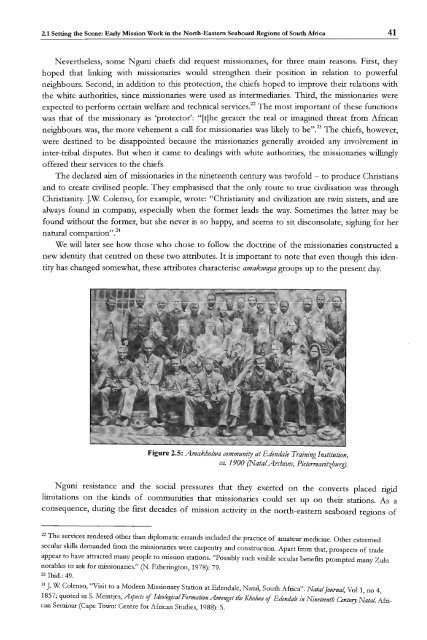South African Choral Music (Amakwaya): Song, Contest and the ...
South African Choral Music (Amakwaya): Song, Contest and the ...
South African Choral Music (Amakwaya): Song, Contest and the ...
Create successful ePaper yourself
Turn your PDF publications into a flip-book with our unique Google optimized e-Paper software.
2.1 Setting <strong>the</strong> Scene: Early Mission Work in <strong>the</strong> North-Eastern Seaboard Regions of <strong>South</strong> Mrica 41<br />
Never<strong>the</strong>less, some Nguni chiefs did request missionaries, for three main reasons. First, <strong>the</strong>y<br />
hoped that linking with missionaries would streng<strong>the</strong>n <strong>the</strong>ir position in relation to powerful<br />
neighbours. Second, in addition to this protection, <strong>the</strong> chiefs hoped to improve <strong>the</strong>ir relations with<br />
<strong>the</strong> white authorities, since missionaries were used as intermediaries. Third, <strong>the</strong> missionaries were<br />
expected to perform certain welfare <strong>and</strong> technical services. 22 The most important of <strong>the</strong>se functions<br />
was that of <strong>the</strong> missionary as 'protector': "[t]he greater <strong>the</strong> real or imagined threat from <strong>African</strong><br />
neighbours was, <strong>the</strong> more vehement a call for missionaries was likely to be".23 The chiefs, however,<br />
were destined to be disappointed because <strong>the</strong> missionaries generally avoided any involvement in<br />
inter-tribal disputes. But when it came to dealings with white authorities, <strong>the</strong> missionaries willingly<br />
offered <strong>the</strong>ir services to <strong>the</strong> chiefs.<br />
The declared aim of missionaries in <strong>the</strong> nineteenth century was twofold - to produce Christians<br />
<strong>and</strong> to create civilised people. They emphasised that <strong>the</strong> only route to true civilisation was through<br />
Christianity. J-W Colenso, for example, wrote: "Christianity <strong>and</strong> civilization are twin sisters, <strong>and</strong> are<br />
always found in company, especially when <strong>the</strong> former leads <strong>the</strong> way. Sometimes <strong>the</strong> latter may be<br />
found without <strong>the</strong> former, but she never is so happy, <strong>and</strong> seems to sit disconsolate, sighing for her<br />
. ,,24<br />
natural comparuon.<br />
We will later see how those who chose to follow <strong>the</strong> doctrine of <strong>the</strong> missionaries constructed a<br />
new identity that centred on <strong>the</strong>se two attributes. It is important to note that even though this identity<br />
has changed somewhat, <strong>the</strong>se attributes characterise amakwC!Ja groups up to <strong>the</strong> present day.<br />
Figure 2.5: Amakholwa community at Edendale Training Institution,<br />
ca. 1900 (NatalArchives, Pietermaritzburg).<br />
Nguni resistance <strong>and</strong> <strong>the</strong> social pressures that <strong>the</strong>y exerted on <strong>the</strong> converts placed rigid<br />
limitations on <strong>the</strong> kinds of communities that missionaries could set up on <strong>the</strong>ir stations. As a<br />
consequence, during <strong>the</strong> first decades of mission activity in <strong>the</strong> north-eastern seaboard regions of<br />
22 The services rendered o<strong>the</strong>r than diplomatic err<strong>and</strong>s included <strong>the</strong> practice of amateur medicine. O<strong>the</strong>r esteemed<br />
secular skills dem<strong>and</strong>ed from <strong>the</strong> missionaries were carpentry <strong>and</strong> construction. Apart from that, prospects of trade<br />
appear to have attracted many people to mission stations. "Possibly such visible secular benefits prompted many Zulu<br />
notables to ask for missionaries." (N. E<strong>the</strong>rington, 1978): 79.<br />
23 Ibid.: 49.<br />
24 J. \XI: Colenso, "Visit to a Modern Missionary Station at Edendale, Natal, <strong>South</strong> Africa". NatalJournal, Voll, no 4,<br />
1857; quoted in S. Meintjes, Aspects of Ideological Formation Amongst <strong>the</strong> Kholwa of Edendale in Nineteenth Century Natal, <strong>African</strong><br />
Seffi11lar (Cape Town: Centre for <strong>African</strong> Studies, 1988): 5.

















